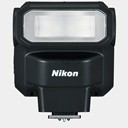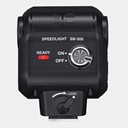All Nikon's flashes are controlled by the smarts in the camera. All the flash does is turn on and off when the camera commands it.
Nikon's top-of-the-line Speedlight enables photographers to be more imaginative with their creative lighting.
| Electronic Construction | Automatic Insulated Gate Bipolar Transistor (IGBT) and series circuitry |
| Guide Number | 18/59 (ISO 100, m/ft) |
| Angle of Coverage | Covers angle of view of 27 mm lens (FX format) or 18 mm lens (DX format) |
| Effective Flash Range | 0.6 m to 20 m (2 ft to 66 ft); varies with ISO sensitivity, bounce angle, and aperture |
| Flash Mode | Flash control mode: i-TTL, manual, Flash mode: Fill flash (front-curtain sync), front-curtain with slow sync,rear- curtain sync, and rear-curtain with slow sync |
| Bounce Capability | Flash rotates vertically up to 120° with stops where the flash is pointing directly, ahead and at 60°, 75°, 90°, and 120° |
| Flash Duration | Lights for about 1/1650 s when fired at full power |
| Power Source | Two AAA alkaline or NiMH batteries, Flash-ready light: Charging complete-Lights, Warning-Blinks, Device On/Off: Power switch used to turn SB-300 on and off |
| Included Accessories | Soft Case SS-DC1 |
| Advanced Features | Locking pin prevents accidental detachment, Other options Thermal cut-out, firmware update |
| Dimension | Approx. 57.4 x 65.4 x 62.3 mm (2.3 x 2.6 x 2.5 in.) |
| Weight | Approx. 120 g (4.2 oz), including two AAA alkaline batteries, Approx. 97 g (3.4 oz), body only |
Nikon's top-of-the-line Speedlight enables photographers to be more imaginative with their creative lighting.



